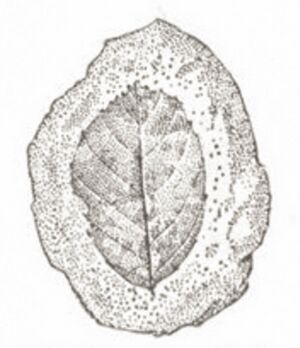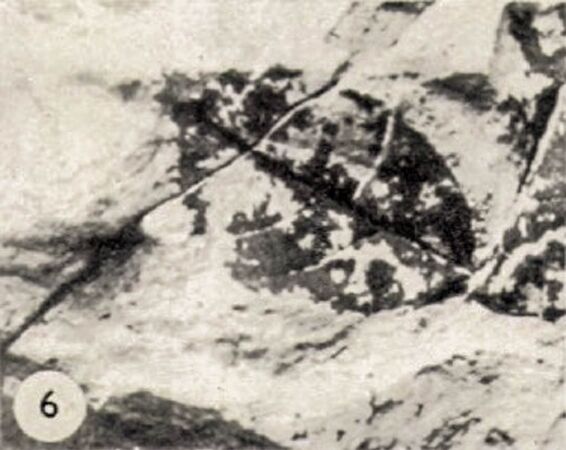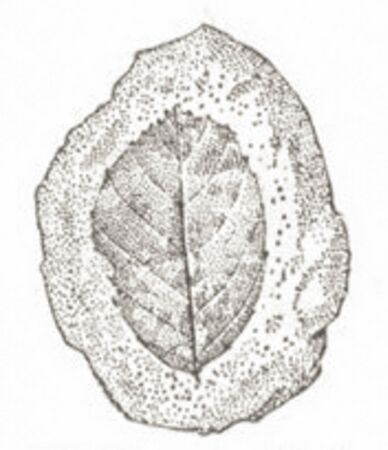Rosa sp. Bánhorvati Andr.
Fossile-Rose, 1959 - beschrieben vom Botaniker/ described by the botanist / décrit par le botaniste Gábor Andreánszky, Ungarn( Hungary/ Hongrie
Eltern/ parentage/ parents: Botanische Rose/ Wild Rose/ Rosier botanique
Vermutliche Synonyme/ Presumed synonyms/ synonymes présumés: Rosa hilliae Lesq., Rosa dubia C.O.Weber
Die Synonyme wurden beschrieben von den Botanikern/ The synonyms were described by the botanists/ Les synonymes ont été décrits par les botanistes Daniel Isaac Axelrod, USA, Shigeru Miki, Japan, Hermann Engelhardt, Deutschland, Charles Arthur Hollick, USA, Ralph Works Chaney, USA, Frank Hall Knowlton, USA, Gábor (Gabriel) Andreánszky, Ungarn, Oswald von Heer, Schweiz, Theodore Dru Alison Cockerell, USA, Hsen Hsu Hu, China, Toshimasa Tanai, Japan, Wladyslaw Szafer, Polen
Allgemeines • Preface • Remarques
Benannt ist diese Rose nach dem Fundort der fossilen Blätter in Bánhorváti[1], im Nordosten Ungarns.
Der Fund stammt aus dem Sarmatium (auch Sarmatische Stufe, Sarmatien oder kurz Sarmat genannt)[2]. Dies ist eine regionale geologische Stufe des Miozäns (Neogen) im zentralen Paratethys-Bereich (Teile von Österreich und Ungarn). Sie entspricht etwa dem oberen Teil der internationalen chronostratigraphischen Stufe des Serravallium (ein Erdzeitalter), das heißt etwa dem Zeitraum von 12,7 bis 11,6 Millionen Jahren.
This rose is named after the place where the fossilised leaflets were found in Bánhorváti[1], in north-eastern Hungary.
The find comes from the Sarmatian (also known as the Sarmatian stage, Sarmatia or Sarmat for short)[2]. This is a regional geological stage of the Miocene (Neogene) in the central Paratethys area (parts of Austria and Hungary). It corresponds approximately to the upper part of the international chronostratigraphic stage of the Serravallian (one geological age), i.e. the period from 12.7 to 11.6 million years ago.
Le nom de cette rose provient du lieu de découverte des feuilles fossiles à Bánhorváti[1], dans le nord-est de la Hongrie.
La découverte date du Sarmatien (également appelé étage sarmatique, Sarmatie ou plus brièvement Sarmat)[2]. Il s'agit d'un étage géologique régional du Miocène (néogène) dans la région centrale de la Paratéthys (parties de l'Autriche et de la Hongrie). Il correspond à peu près à la partie supérieure de l'étage chronostratigraphique international du Serravallium (un âge de la Terre), soit environ la période de 12,7 à 11,6 millions d'années.
Originale Beschreibung • Original description • Description originale
Originalbeschreibung:
Rosa sp. (Abb. 152, Taf. XLI. 6).
Außer R. legányii Andreánszky, n. sp. kommt in unseren Sarmatfloren noch ein anders beschaffenes Blättchen einer anderen Rosenart vor, die wir kurz beschreiben.
Ein Blättchen aus Bánhorváti, Verőbánya (Nr. 23447 der Sammlung des Naturhist. Museums) ist 2,5 cm lang, 1,5 cm breit, leicht oboval-elliptisch, im unteren Teil ganzrandig, im oberen fein bucbtig gezähnelt. Seitennerven 5-paarig, sie gehen in einem Winkel von etwa 50° aus, sind schwach nach vorne gebogen und bogenläufig. Das Blättchen kann mit denen unserer Rosa-Arten verglichen werden. Ein anderes Blättchen aus der unteren Schicht von Bánhorváti ist diesem Blättchen sehr ähnlich.
Translation:
Rosa sp. (Abb. 152, Taf. XLI. 6).
Apart from R. legányii Andreánszky, n. sp., there is another leaflet of a different type of rose in our Sarmatian floras, which we describe briefly.
A leaflet from Bánhorváti, Verőbánya (No. 23447 in the collection of the Natural History Museum) is 2.5 cm long, 1.5 cm wide, slightly oboval-elliptic, with entire margins in the lower part and finely bucbtly serrated in the upper part. Lateral veins 5-paired, they extend at an angle of about 50°, are slightly bent forwards and arcuate. The leaflet can be compared with those of our Rosa species. Another leaflet from the lower layer of Bánhorváti is very similar to this leaflet.
Traduction:
Rosa sp. (Abb. 152, Taf. XLI. 6).
Outre R. legányii Andreánszky, n. sp., on trouve dans nos flores sarmates une petite feuille d'une autre espèce de rose, de nature différente, que nous décrivons brièvement.
Une feuille de Bánhorváti, Verőbánya (n° 23447 de la collection du Muséum d'histoire naturelle) mesure 2,5 cm de long, 1,5 cm de large, légèrement obovale-elliptique, à bord entier dans la partie inférieure, finement denticulée en bucbys dans la partie supérieure. Les nervures latérales sont au nombre de 5 paires, elles partent à un angle d'environ 50°, sont faiblement courbées vers l'avant et arquées. La foliole peut être comparée à celles de nos espèces de Rosa. Une autre feuille de la couche inférieure de Bánhorváti est très semblable à cette feuille.
Fundort • Find location • Lieu de découverte
Gefunden wurden die fossilen Blätter dieser Rose in Bánhorváti[1], im Nordosten Ungarns.
The fossilised leaflets of this rose were found in Bánhorváti[1], in north-eastern Hungary.
Les feuilles fossiles de cette rose ont été trouvées à Bánhorváti[1], dans le nord-est de la Hongrie.
- Rosa sp. Bánhorvati Andr.
Zum Vergrößern anklicken • click to enlarge • cliquez pour agrandir
↑ Nach oben • Top • Vers le haut ↑
Einzelnachweis • Footnotes • Notes
Weblinks • External links • Liens externes
Literatur • Literature • Littérature
- Gábor Andreánszky, Die Flora der sarmatischen Stufe in Ungarn, 1959 Seite 142 - Text u. Bild u. Tafel XLI, Fig. 6
- Herman F. Becker, The fossil record of the genus Rosa, 1963 Rosa sp. Bánhorvati



